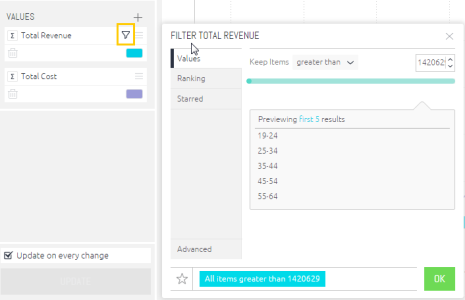Creating Widget Filters
This topic describes how you can use the Widget Designer to create widget filters and add widget filters to an existing field.
In the Widget Designer, you can define a filter for the data in a widget. or example, you can create a filter that only shows the fields of relevant countries. The filters are not visible in the dashboard, nor can they be edited directly from the dashboard.
For a short video overview of widget filters, see below:
Note:
Note about duplicate filtering: When creating a widget filter for a field that is already filtered in a dashboard filter, the widget filter will override the dashboard filter. For example: You have a dashboard filter, filtering the months field, with the values January and February selected. At the same time you create a filter for a widget, also for months, but this time March and April are selected. When both filters are applied in the dashboard, you will see data for March and April in the widget, according to the widget’s filter. If your widget is filtered using measured values, then the measured value will override any other widget or dashboard filters you have for the same fields.
Creating a Widget Filter
To add a widget filter:
-
Open (edit) this Widget in the Widget Designer, as described in Adding Widgets to a Dashboard.
-
Click the Filters tab in the Widget Designer.
-
The Filters panel is displayed showing the filters defined for this Widget. Click on the Add Filter button to display the Data Browser, which lists the fields in the ElastiCube.

-
Click on a field in the Data Browser to add it as a filter. You can define multiple filters, each for a different field. These filters have an AND relationship between them. Each filter that you define appears on the Widget Filters panel on the right, enabling you to easily edit it if needed. The procedure for defining a Widget filter is similar to the procedure for defining a Dashboard filter, as described in Creating Dashboard Filters. The difference is that the widget filter only affects its hosting widget, and is accessible only via the widget designer, not directly from the dashboard.
Adding a Widget Filter to an Existing Field
Adding a new widget filter, as described above, lets you use any field as a widget filter. Sometimes you want to directly filter a field that is already part of the widget and visible in the data panel on the left.
To add a Widget Filter to an existing field:
- Hover over the field you want to filter, and click the FILTER icon.

.r.